When it comes to 800V, the current car companies mainly promote the 800V fast charging platform , and consumers subconsciously think that 800V is the fast charging system.
In fact, this understanding is somewhat misunderstood. To be precise, 800V high-voltage fast charging is just one of the features of the 800V system.
In this article, I intend to systematically show readers a relatively complete 800V system from five dimensions, including:
1. What is the 800V system on the new energy vehicle?
2. Why is 800V introduced at the moment?
3. What intuitive benefits can the 800V system currently bring?
4. What are the difficulties in the current 800V system application?
5. What is the possible charging layout in the future?
01. What is the 800V system on the new energy vehicle?
The high-voltage system includes all high-voltage components on the high-voltage platform. The following figure shows the high-voltage components of a typical new energy pure electric vehicle equipped with a water-cooled 400V voltage platform battery pack.
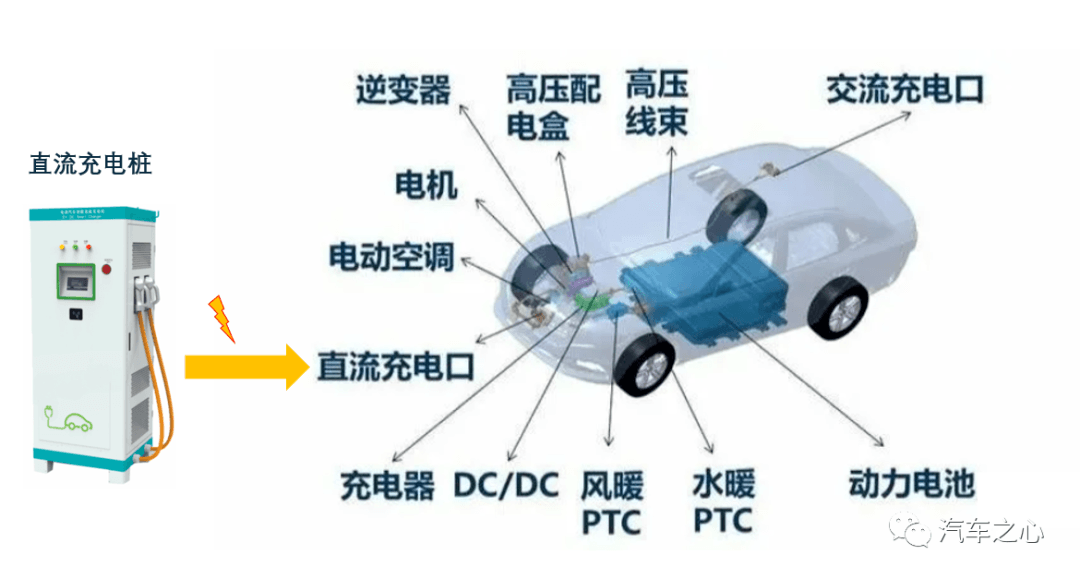
The voltage platform of the high-voltage system is derived from the output voltage of the vehicle power battery pack.
The specific voltage platform range of different pure electric models is related to the number of cells connected in series in each battery pack and the type of cells (ternary, lithium iron phosphate, etc.) .
Among them, the number of ternary battery packs in series with 100 cells is about 400V high voltage.
The 400V voltage platform we often say is a broad term. Take the 400V platform Jikrypton 001 as an example. When the ternary battery pack carried by it goes from 100% SOC to 0% SOC , its voltage change width is close to 100V (about 350V-450V). ) .

3D drawing of high voltage battery pack
Under the current 400V high-voltage platform, all parts and components of the high-voltage system work under the 400V voltage level, and the parameter design, development and verification are carried out according to the 400V voltage level.
To achieve a full 800V high-voltage platform system, first of all, in terms of battery pack voltage, an 800V battery pack needs to be used, corresponding to about 200 ternary lithium battery cells in series.
Followed by motors, air conditioners, chargers, DCDC support 800V and related wiring harnesses, high-voltage connectors and other parts on all high-voltage circuits are designed, developed and verified in accordance with 800V requirements.
In the development of the 800V platform architecture, in order to be compatible with the 500V/750V fast charging piles on the market, 800V pure electric vehicles will be equipped with 400V to 800V boost DCDC modules for a long time .
Its function is to timely decide whether to activate the boost module to charge the 800V battery pack according to the actual voltage capability of the charging pile .
According to the combination of cost performance, there are roughly two types:
One is the full 800V platform architecture .
All parts of the vehicle in this architecture are designed for 800V.

Full 800V high voltage system architecture
The second category is the cost-effective part of the 800V platform architecture .
Retain some 400V components : Since the cost of current 800V power switching devices is several times that of 400V IGBTs, in order to balance the cost of the entire vehicle and drive efficiency, OEMs are motivated to use 800V components (such as motors) onKeep some 400V parts (eg electric air conditioner, DCDC) .
Multiplexing of motor power devices : Since there is no need to drive during the charging process, cost-sensitive OEMs will reuse the power devices in the rear axle motor controller for 400V-800 boost DCDC.
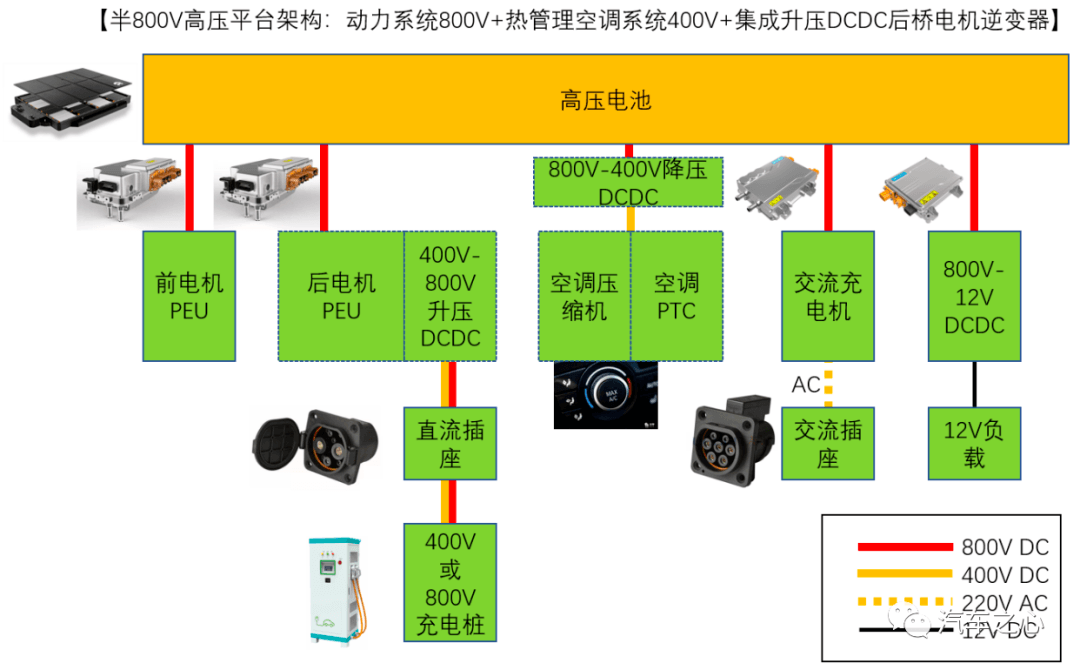
Power System 800V Platform Architecture
02. Why do new energy vehicles introduce 800V systems at the moment?
In the daily driving of current pure electric vehicles, about 80% of the electricity is consumed in the drive motor.
The inverter, or motor controller, controls the electric motor and is one of the most important components in a car.
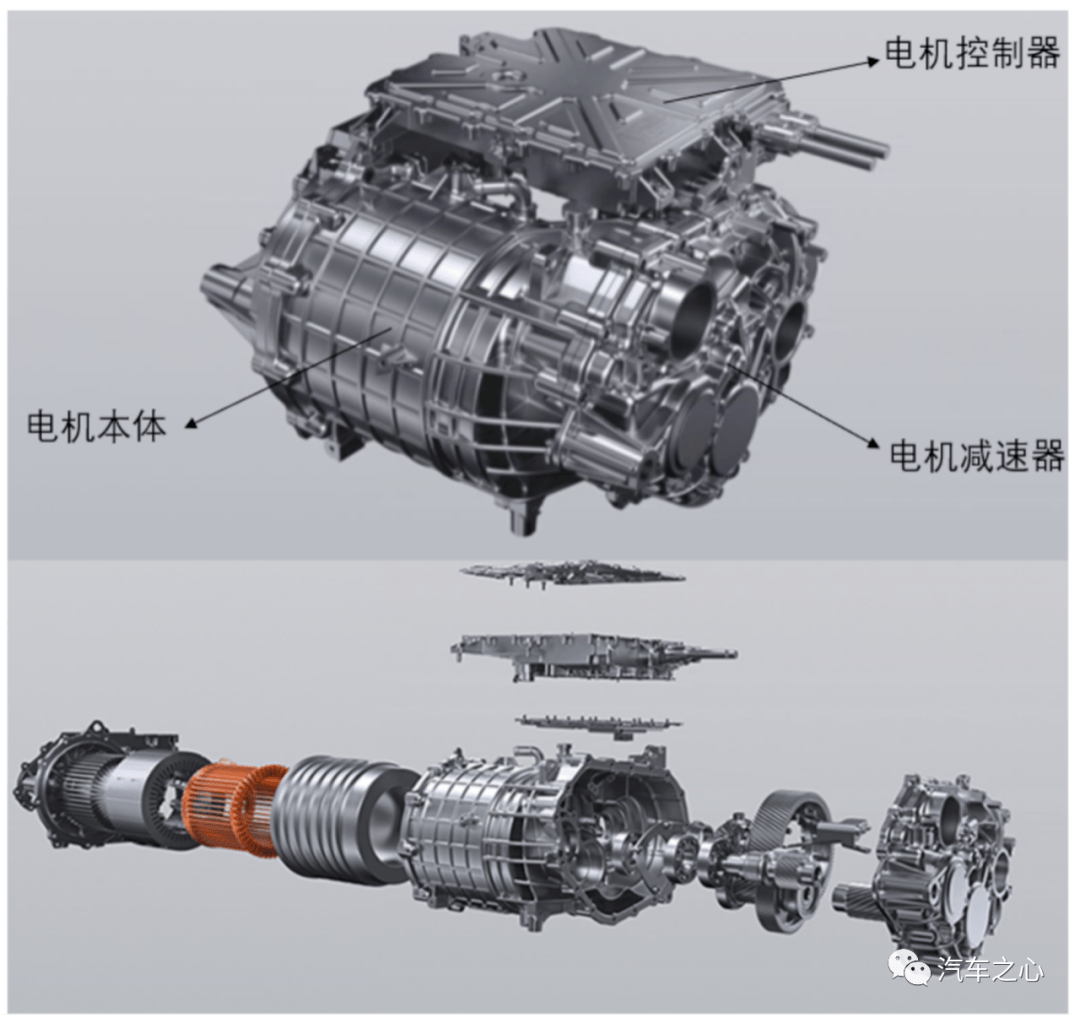
Three-in-one electric drive system
In the Si IGBT era, the efficiency improvement of the 800V high-voltage platform is small, and the application power is insufficient.
The efficiency loss of the drive motor system is mainly composed of the motor body loss and the inverter loss:
The first part of the loss – the loss of the motor body:
- Copper loss – heat loss on the motor stator winding (copper wire) ;
- Iron loss In systems where the motor uses magnetic force, the heat loss (Joule heat) caused by eddy currents generated in the iron (or aluminum) part of the motor due to changes in the magnetic force ;
- Stray losses are attributed to the losses caused by the irregular flow of charge;
- wind loss.
A certain type of 400V flat wire motor as follows has a maximum efficiency of 97%, and the 400V Extreme Krypton 001 Wei Rui motor body is said to have a maximum efficiency of 98% .
In the 400V stage, which has reached the highest efficiency of 97-98%, simply using the 800V platform has limited space for reducing the loss of the motor itself.
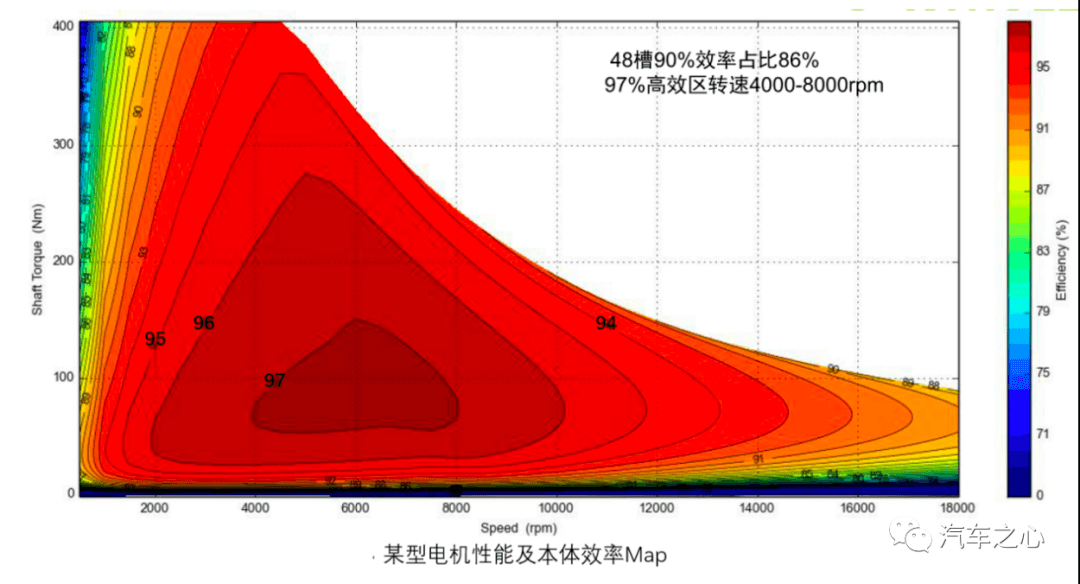
Part 2 Losses: Motor Inverter Losses:
- conduction loss;
- switching losses.
The following is the Honda 400V platform IGBT motor inverter efficiency Map[1]. More than 95% of the high-efficiency areas are close to 50%.

From the comparison of the current loss status of the two parts:
In the rough comparison between the motor body loss (>2%) and the motor inverter loss (>4%) , the inverter loss is relatively large.
Therefore, the driving range of the car is more related to the efficiency of the main inverter of the drive motor.
Before the maturity of the third-generation power semiconductor SiC MOSFET, the power components of new energy vehicles, such as the drive motor, use Si IGBT as the switching device of the inverter, and the supporting voltage level is mainly about 650V. Power grids, electric locomotives and other non-consumption occasions.
From a feasibility point of view, a new energy passenger vehicle can theoretically use an IGBT with a withstand voltage of 1200V as the power switch of an 800V motor controller, and an 800V system will be developed in the IGBT era.
From the perspective of cost performance, the 800V voltage platform has limited improvement in the efficiency of the motor body. The continuous use of 1200V IGBTs does not improve the efficiency of the motor inverter, which accounts for the majority of losses. Instead, it brings a series of development costs. Most car companies have no power application in the IGBT era. 800V platform.
In the era of SiC MOSFETs, the performance of 800V systems began to be improved due to the birth of key components.
After the advent of the third-generation semiconductor material silicon carbide power devices, it has received extensive attention due to its excellent characteristics [2]. It combines the advantages of high frequency Si MOSFETs and high voltage Si IGBTs:
- High operating frequency – up to MHz level, higher modulation freedom
- Good voltage resistance – up to 3000 kV, wide application scenarios
- Good temperature resistance – can run stably at a high temperature of 200 ℃
- Small integrated size – higher operating temperature reduces heatsink size and weight
- High Operational Efficiency – Adoption of SiC power devices increases the efficiency of power components such as motor inverters due to reduced losses. Take the Smart Genie as an example below. Under the same voltage platform and basically the same road resistance (almost no difference in weight/shape/tire width), all of them are Virui motors. Compared with IGBT inverters, the overall efficiency of SiC inverters is improved by about 3%. Note: The actual improvement of inverter efficiency is also related to the hardware design capabilities and software development of each company.

Early SiC products were limited by the SiC wafer growth process and chip processing capabilities, and the single-chip current-carrying capacity of SiC MOSFETs was much lower than that of Si IGBTs.

In 2016, a research team in Japan announced the successful development of a high power density inverter using SiC devices, and later published the results in (Electrical and Electronic Engineering Transactions of the Institute of Electrical Engineers of Japan) IEEJ[3]. The inverter had a maximum output of 35kW at the time.
In 2021, with the progress of technology year by year, the current carrying capacity of mass-produced SiC MOSFETs with a withstand voltage of 1200V has improved, and products that can adapt to powers of more than 200kW have been seen.

At this stage, this technology has begun to be applied in real vehicles.
On the one hand, the performance of power electronic power devices tends to be ideal. SiC power devices have higher efficiency than IGBTs, and can match the withstand voltage capability (1200V) of the 800V platform , and have developed to a power capability of more than 200kW in recent years;
On the other hand, the 800V high-voltage platform gains can be seen. The doubling of the voltage brings the upper limit of the charging power of the whole vehicle higher, the copper loss of the system is lower, and the power density of the motor inverter is higher (characteristically, the torque & power of the same size motor is higher) ;
The third is to increase involution in the new energy market. The pursuit of high cruising range and faster energy replenishment on the consumer side, the enterprise side is eager to make the difference in the powertrain difference in the new energy market;
The above factors have finally brought about the large-scale exploration and application of new energy 800V high-voltage platforms in the past two years. Currently listed 800V platform models include Xiaopeng G9, Porsche Taycan and so on.
In addition, SAIC, Krypton, Lotus , Ideal, Tianji Automobile and other car companies also have related 800V models ready to be introduced to the market.
03. What intuitive benefits can the 800V system currently bring?
The 800V system can theoretically list many advantages. I think the most intuitive benefits for current consumers are mainly the following two.
First , the battery life is longer and more solid , which is the most intuitive benefit.
At the power consumption level of 100 kilometers under CLTC operating conditions, the benefits brought by the 800V system (the picture below shows the comparison between Xiaopeng G9 and BMW iX3, the G9 is heavier, the body is wider, and the tires are wider, all of which are unfavorable factors for power consumption) , conservative estimates There is a 5% boost.

At high speeds, the energy consumption improvement of the 800V system is said to be more pronounced.
During the launch of the Xiaopeng G9, manufacturers deliberately guided the media to conduct high-speed battery life tests. Many media reported that the 800V Xiaopeng G9 achieved a high high-speed battery life rate (high-speed battery life/CLTC battery life*100%) .
The actual energy-saving effect requires further confirmation from the follow-up market.
The second is to give full play to the capabilities of existing charging piles .
400V platform models, when facing 120kW, 180kW charging piles, the charging speed is almost the same. (The test data comes from Chedi) The DC boost module used by the 800V platform model can directly charge the existing low-voltage charging pile (200kW/750V/250A) that is not limited by the grid power to the full power of 750V/250A.
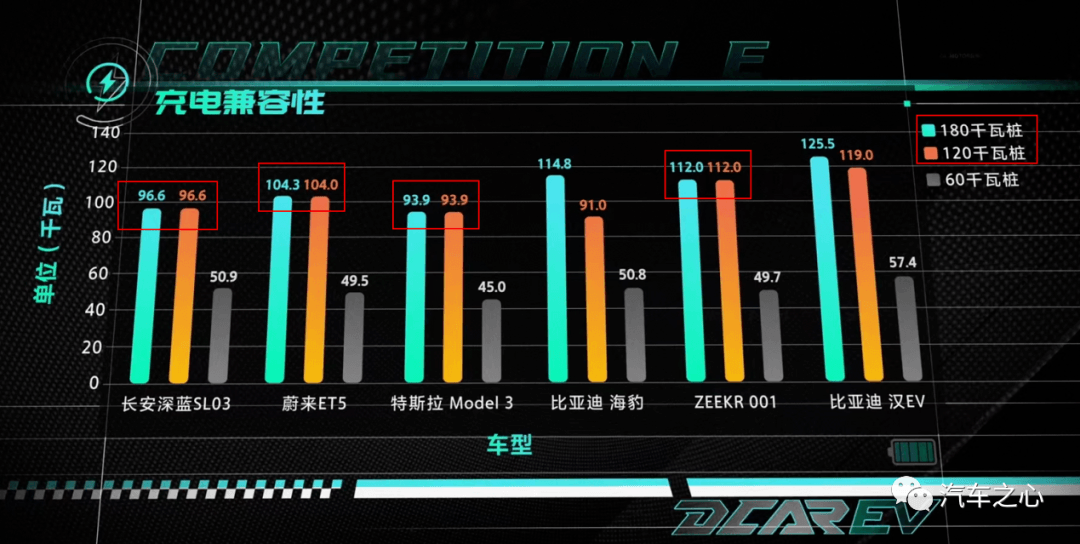
Note: The actual full voltage of Xpeng G9 is below 800V due to engineering considerations.
Taking the example pile as an example, the charging power of the Xiaopeng G9 (800V platform) with the same 100-degree battery pack is nearly 2 times that of the JK 001 (400V platform) .
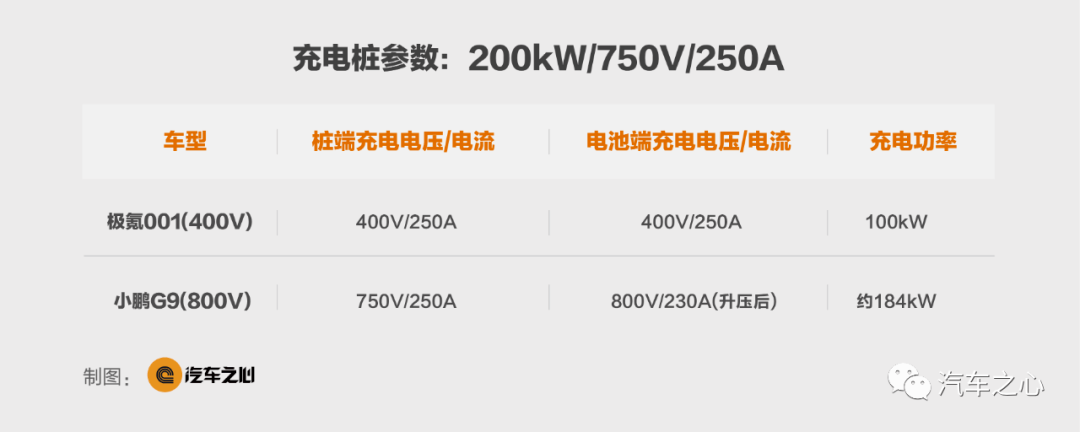
04. What are the difficulties in the current 800V system application?
The biggest difficulty of 800V application is still inseparable from cost.
This cost is divided into two parts: component cost and development cost.
Let’s start with the cost of parts.
High-voltage power devices are expensive and used in large quantities. The design of the overall 1200-voltage high-voltage power device with full 800V architecture uses more than 30 , and at least 12 SiC for dual-motor models .

As of September 2021, the retail price of 100-A discrete SiC MOSFETs (650 V and 1,200 V) is almost 3 times the price of an equivalent Si IGBT . [4]
As of October 11, 2022, I learned that the retail price difference between two Infineon IGBTs and SiC MOSFETs with similar performance specifications is about 2.5 times . (Data source Infineon official website October 11, 2022)
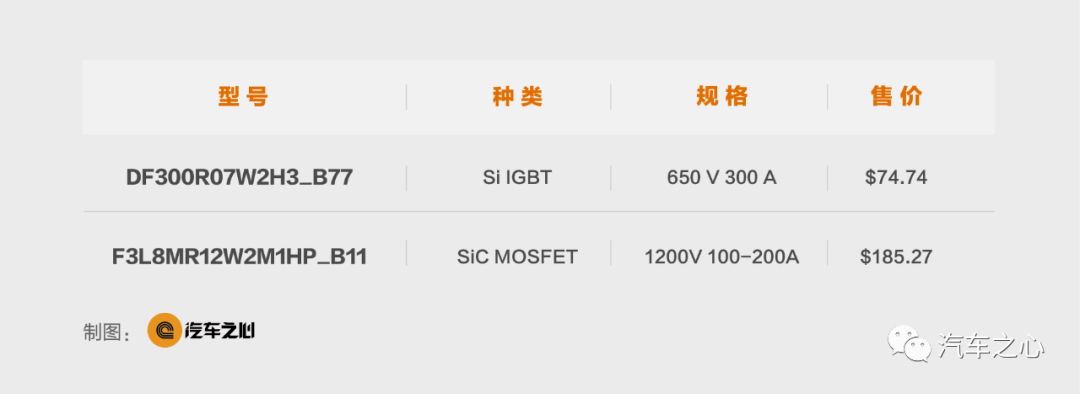
Based on the above two data sources, it can be basically considered that the current market SiC is about 3 times the price difference of IGBT.
The second is the development cost.
Since most of the 800V-related parts need to be redesigned and verified, the test volume is larger than that of small iterative products.
Some of the test equipment in the 400V era will not be suitable for 800V products, and new test equipment needs to be purchased.
The first batch of OEMs to use 800V new products usually need to share more experimental development costs with component suppliers.
At this stage, OEMs will choose 800V products from established suppliers for the sake of prudence, and the development costs of established suppliers will be relatively higher.
According to the estimation of an automobile engineer of an OEM in 2021, the cost of a 400kW-level pure electric vehicle with a full 800V architecture and a dual-motor 400kW system will increase from 400V to 800V , and the cost will increase by about 10,000-20,000 yuan .
The third is the low cost performance of the 800V system .
Taking a pure electric customer using a home charging pile as an example, assuming a charging cost of 0.5 yuan/kWh and a power consumption of 20kWh/100km (typical power consumption for high-speed cruise of medium and large EV models) , the current rising cost of the 800V system can be used by the customer for 10- 200,000 kilometers.
The energy cost saved by the efficiency improvement in the vehicle life cycle (based on the efficiency improvement of the high-voltage platform and SiC, the author roughly estimates the efficiency gain of 3-5%) cannot cover the increase in vehicle prices.
There is also a market limitation for 800V models.
The advantages of the 800V platform in terms of economy are not obvious, so it is suitable for high-performance B+/C-class models that have the ultimate pursuit of vehicle performance and are relatively insensitive to the cost of a single vehicle.
This type of vehicle has a relatively small market share.
According to the breakdown of the data of the Passenger Federation, from January to August 2022, according to the price class analysis of new energy vehicles in China, the sales volume of 200,000-300,000 accounted for 22% , the sales of 300,000 to 400,000 accounted for 16% , and the sales of more than 400,000 accounted for 4 % .
Taking the price of 300,000 vehicles as the boundary, in the period when the cost of 800V components is not significantly reduced, 800V models can account for about 20% of the market share .

Fourth, the 800V parts supply chain is immature .
The 800V system application requires the redevelopment of the original high voltage circuit parts. High-voltage platform batteries, electric drives, chargers, thermal management systems and parts, most of the Tire1 and Tire2 are still in the development stage and have no experience in mass production applications. There are few suppliers for OEMs, and relatively mature products are prone to emerge due to unexpected factors. productivity issues.
Fifth, the 800V aftermarket is under-validated .
The 800V system uses many newly developed products (motor inverter, motor body, battery, charger + DCDC, high-voltage connector, high-voltage air conditioner, etc.) , and it is necessary to verify the clearance, creepage distance, insulation, EMC, heat dissipation, etc.
At present, the product development and verification cycle in the domestic new energy market is short (usually, the development cycle of new projects in old joint ventures is 5-6 years, and the current development cycle in the domestic market is less than 3 years). At the same time, the actual vehicle market inspection time of 800V products is insufficient, and the probability of subsequent after-sales is relatively high. .
Sixth, the practical application value of 800V system fast charging is not high.
When car companies promote 250kW , 480kW (800V) high-power super fast charging, they usually publicize the number of cities where the charging piles are laid, intending to guide consumers to think that they can enjoy this experience at any time after purchasing a car, but the reality is not so good.
There are three main constraints:
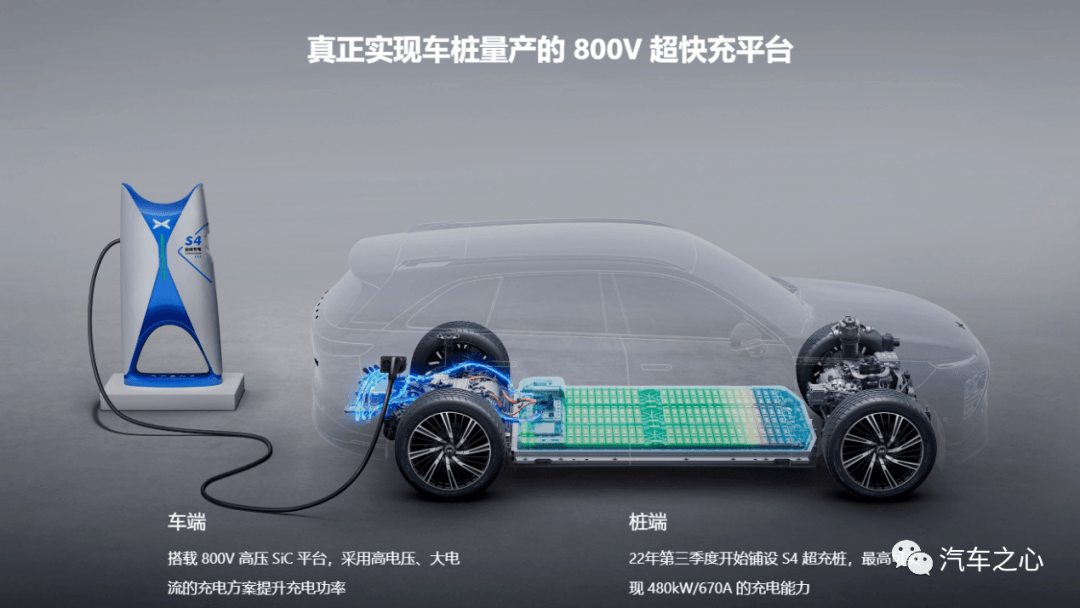
Xiaopeng G9 800V High Voltage Fast Charge Brochure
(1) 800V charging piles will be added .
At present, the more common DC charging piles on the market support a maximum voltage of 500V/750V and a limited current of 250A, which cannot give full play to the fast charging capability of an 800V system (300-400kW) .
(2) There are constraints on the maximum power of 800V supercharged piles .
Taking Xiaopeng S4 supercharger (high pressure liquid cooling) as an example, the maximum charging capacity is 480kW/670A. Due to the limitation of power grid capacity, the demonstration station only supports single-vehicle charging, which can exert the highest charging power of 800V models. During peak hours, simultaneous charging of multiple vehicles will cause power diversion.
According to the example of power supply professionals: schools with more than 3,000 students in the eastern coastal area apply for a 600kVA capacity, which can support a 480kW 800V supercharged pile based on an estimate of 80% efficiency.
(3) The investment cost of 800V supercharged piles is high .
This involves transformers, piles, energy storage, etc. The actual cost is estimated to be greater than that of the swap station, and the possibility of large-scale deployment is low.
800V supercharging is only the icing on the cake, so what kind of charging facility layout can improve the charging experience?
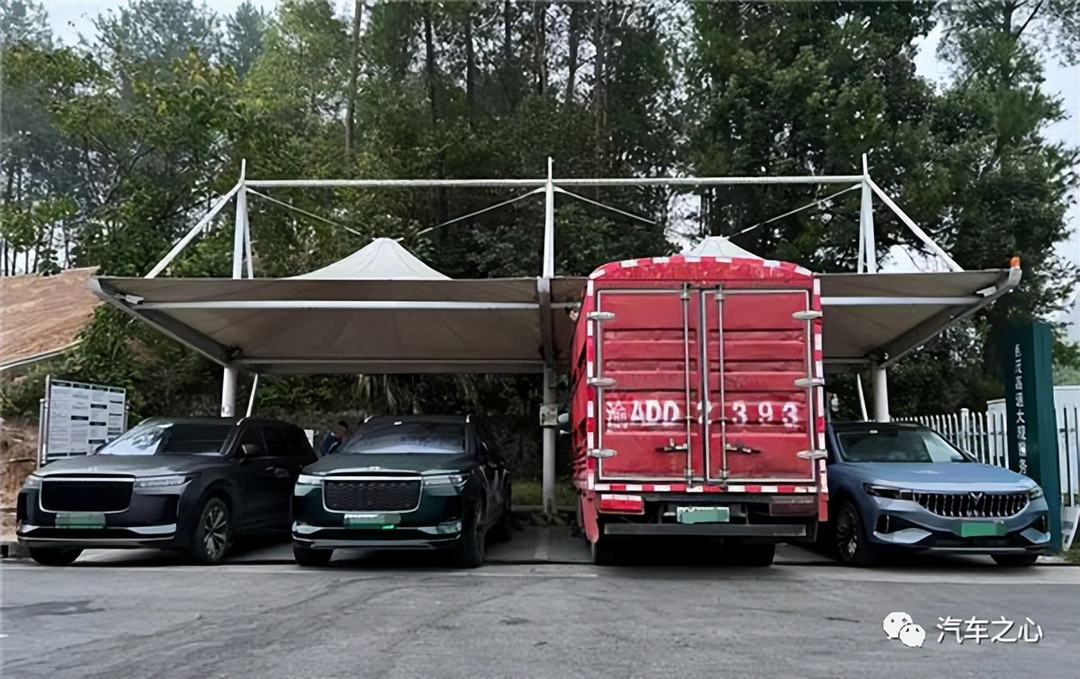
2022 Holiday High Speed Charging Field
05. Imagination of the layout of charging facilities in the future
At present, in the entire domestic charging pile infrastructure, the vehicle-to-pile ratio (including public piles + private piles) is still at the level of about 3:1 (based on 2021 data) .
With the increase in the sales of new energy vehicles and the relief of consumers’ charging concerns, it is necessary to increase the vehicle-to-pile ratio. Various specifications of fast-charging piles and slow-charging piles can be reasonably arranged in destination scenarios and fast-charging scenarios, in order to improve the charging experience. To improve, and can really balance the grid load.
The first is destination charging , charging without additional waiting time:
(1) Residential parking spaces: A large number of shared and orderly slow charging piles within 7kW are built, and oil vehicles are given priority to park non-new energy parking spaces, which can meet the needs of residents, and the laying cost is relatively low, and the orderly control method can also avoid exceeding the regional power grid. capacity.
(2) Shopping malls/scenic spots/industrial parks/office buildings/hotels and other parking lots: 20kW fast charging is supplemented, and a large number of 7kW slow charging are built. Development side: low cost of slow charging and no expansion cost; consumer side: avoid occupying space/moving cars after fast charging is fully charged in a short period of time.
The second is fast energy replenishment , how to save the overall energy consumption time:
(1) Expressway service area: maintain the current number of fast charging, strictly limit the charging upper limit (such as 90%-85% of the peak), and ensure the charging speed of long-distance driving vehicles.
(2) Gas stations near the highway entrance in major cities/towns: configure high-power fast charging, and strictly limit the charging upper limit (such as 90%-85% at peak) , as a supplement to the high-speed service area, close to the long-distance driving of new energy users demand, while radiating the city/town ground charging demand. Note: Usually, the ground gas station is equipped with a 250kVA electric capacity, which can roughly support two 100kW fast charging piles at the same time.
(3) Urban gas station/open-air parking lot: configure high-power fast charging to limit the upper limit of charging. At present, PetroChina is deploying fast charging/exchange facilities in the new energy field, and it is expected that more and more gas stations will be equipped with fast charging piles in the future.
Note: The geographical location of the gas station/open-air parking lot itself is close to the roadside and the building features are more obvious, which is convenient for charging customers to quickly find the pile and leave the site quickly.
06. Write at the end
At present, the 800V system still faces many difficulties in cost, technology and infrastructure. These difficulties are the only way for the innovation and development of new energy vehicle technology and industrial iteration. stage.
Chinese car companies, with their fast and efficient engineering application capabilities, may be able to realize a large number of rapid applications of 800V systems, and take the lead in leading the trend of technology in the field of new energy vehicles.
Chinese consumers will also be the first to enjoy the high-quality vehicle experience brought about by technological progress. It is no longer like in the era of fuel vehicles, when domestic consumers buy old models from multinational car companies, old technology or technology castrated products.
References:
[1] Honda Technology Research: Development of Motor and PCU for a SPORT HYBRID i-MMD System
[2] Han Fen, Zhang Yanxiao, Shi Hao. Application of SiC MOSFET in Boost circuit [J]. Industrial Instrumentation and Automation Device, 2021(000-006).
[3] Koji Yamaguchi, Kenshiro Katsura, Tatsuro Yamada, Yukihiko Sato .High Power Density SiC-Based Inverter with a Power Density of 70 kW/liter or 50 kW/kg[J]. IEEJ Journal of Industry Applications
[4] PGC Consultancy Article: Taking Stock of SiC, Part 1: a review of SiC cost competitiveness and a roadmap to lower costs
Post time: Oct-21-2022